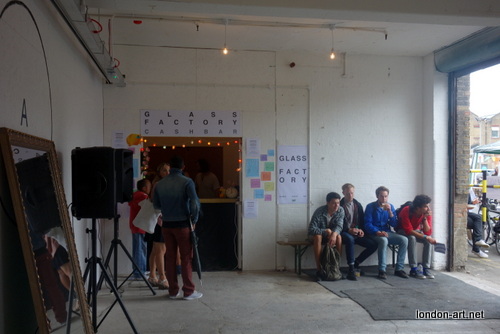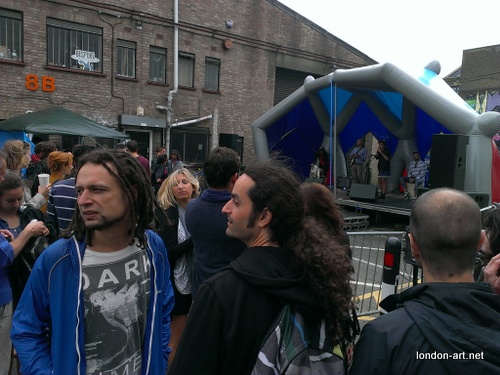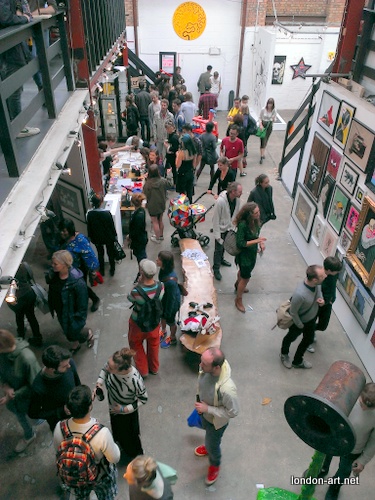by Vanessa Champion
Red Never Follows
Saatchi Gallery
31.07-01.09.2013
Blood red light seeps across the ash white canvas that is the second floor of the Saatchi Gallery; on entering the exhibition space you are immediately transported to somewhere that feels at once safe and dangerous, the warmth of the colour is almost womb-like and yet the movement on the walls around you disturbs the equilibrium. There’s a symphony of technology, design and conceptualisation that is playing out around you, and you are aware that innovation and creativity are at the root of each installation.
20 years ago in 1993, Hugo Boss was launched, and this exhibition is a collaboration by the brand with 20 urban creatives. I spoke to Christoph Frank of Platoon, the curators based in Germany, who said that in selecting the work and the creators, the importance was “innovation and creativity.” They actively sought those who were taking a “different approach which is in keeping with the ideology of Hugo Boss.” This originality of imagination truly resonates loud and clear through the exhibition. Also it is clear that there is an inventive resourcefulness of those from different disciplines. Again, like Hugo Boss is wont to do, pushing boundaries of expectation and preconception, the art on show here might not necessarily fall into the usual “fine art” disciplines. We don’t recognise the traditional arts of painting, photography, drawing, no we have visuals and installations by designers, film directors, engineers, architects from all over the world, from Germany to Japan, Portugal to LA and that I think makes the richness of the collection unique and pioneering.
This leads to the question, what makes art ‘art’? Not that long ago, photography was criticised for being an almost mechanistic form of representation, not real “art” and then in walks Ansell Adams who one could argue, might blow away even the most cynical sceptic as he used knowledge, analysis and technology to achieve and manifest his own artistic and creative aims. So too, we have here in this exhibition, individuals who “know” what their respective technology can do and are adopting it to originate representative forms. It’s a really interesting concept for a show, and one which I feel the curators have really pulled off.
Güvenç Özel & his work
Güvenç Özel now residing in LA, but originally from Turkey, an architect and artist has created a ‘cave’ of paper, constructed out of folded triangles forming pentagrams which breathe in response to the signals emitted from a headset worn by the listener. Red light bathes the interior. Güvenç told me that it is a wireless device that maps mind waves. Disturbing maybe, but incredibly thought provoking, as he said, the cave breathes in response to our mind, thus we can make manifest thought patterns and control the space around us.
Luke Taylor and Chris Barrett with their vinyls
Have you ever sat and been mesmerised by the sound “heart-beat” patterns on SoundCloud? No? I suggest you take a look, find a track and listen. That’s just what inspired US (Luke Taylor and Chris Barrett based in Kingston, London) as film directors to create a 3D stop motion of a track by hip-hop musician Wiley. A great dumb-bell like row of old vinyl each cut accurately to size to represent the beats and course of the track. They had to film it in “reverse” they told me. Creating the whole track first with the vinyl then cutting it off in reverse time. The piece here they painstakingly have recreated. I love it that the old vinyl which would have likely ended up in landfill has found a new voice in these guys’ hands.
Julian Adenauer & his work
A flat black robot seems to float effortlessly and somewhat determinedly across one expanse of wall, painting red over and over again, like some gothic medical cat’s cradle. I chatted to Julian Adenauer (one half of Sonice Development, the other half is Michael Haas) who explained the science behind the weird anomaly suctioned to the wall of the gallery. The lightweight plastic of “Big Ben” (their nickname for it) gradually will create a dense colour space as it will move for 200 hours, the longest they have run it. Different colours are used including complementary ones to make, enrich and deepen the tones.
Marco Barotti & his work
A big red plastic dome sits in the centre of the second room, it is see through and has a big circular rubber slit you step through (somewhat ungainly in my case with heeled boots and camera slung over my shoulder) and you clip a little black devise to your ear-lobe. You relax and then the technology which is strapped into the big red dome above you, interprets your heartbeat to create vibrations and sounds around you. It’s weird, after stepping through the ‘slit’ it feels as though you have entered into yourself (no, I’ve not taken anything, ed.). “It’s all about human interaction” said Marco Barotti, of ‘Plastique Fantastique’. He’s Italian living in Berlin. I really enjoyed talking with him, his ideas and vision you can almost feel bouncing off of him. He is fascinated by music and architecture, and it is no wonder as he studied percussion at the Siena Jazz Foundation also. He is interested in different forms of architecture and how you can bring human interplay to change and create the space.
Other installations worthy of note were the wall of videos, Armin Keplinger 1:1000 where what looks like a piece of internal flesh is suspended, spikes poke out slowly and then morph into vertical droplets which slip and gloop audibly down the screen. Bart Hess ‘Mutants’ video was mesmerising as a man trapped inside a rubber suit, pushes and stretches his shiny prison which reflects fluorescent lights that cloak him with a dismembered exo-skeleton.
Eliza Strozyk & her work
Not many women featured, in fact one in her own right, Eliza Strozyk from Germany, triangular wood pieces on fabric, which creates a structural blanket of crimson and red fading to almost peach and natural wood.
Jun Fujiwara's work
The exhibition is clearly a celebration of the Hugo Boss brand, the famous ‘red’ sailing through the whole concept, you can’t help but feel, it is an amazing positive idea for creatives to express themselves on an international platform here at the Saatchi Gallery that is renowned for exploring and freeing the wings of the new and original, and after all isn’t that what design, art and creativity is all about? Collaboration and expression? The arts need patronage and I’m all for wherever that spark comes from. It’s opened up a whole new box of ideas for me, and I’m looking forward to exploring these artists’ works some more.








































